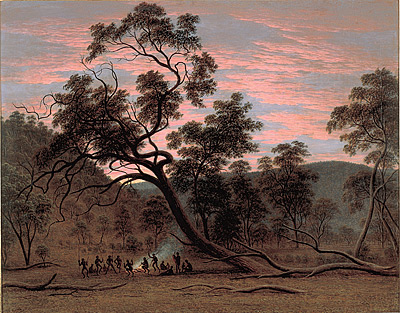Transferring the Tasmanians to Flinders Island, restricting their movement, and dousing them with grim, Dickens era Christianity …
…Some two hundred Tasmanians were sent to Wybalenna, and there, slowly, far away and out of sight, forgotten by the settlers, guarded by second-rate officials and homesick soldiers, the race wasted away in tedium. At first the aborigines seemed happy enough- they were pleased with the warm clothing the government gave them, and the hot food- but gradually they sank into apathy. They needed to wander, and the pined for the limitless forests of their larger island. They died by the dozen, of chest complaints, stomach troubles, and plain homesickness: there was nothing for them to do but brood, forlornly dance and sing, listlessly look for opossums and kangaroos, or dig for potatoes in their garden patch.

—When Glover arrived in Hobart in 1831, the thirty-year conflict between the Tasmanian Aborigines and the European settlers was nearing an end. During this time George Augustus Robinson – the appointed Protector of Aborigines – had been relocating the majority of two hundred Indigenous people to Flinders Island. Only two months before he left Hobart for his new property of Patterdale in northern Tasmania, Glover made two group portraits showing twenty-six members of the Big River and Oyster Bay Aboriginal tribes before their transfer to Flinders Island. They became the subject of a number of significant paintings. Painted in 1832, the year of his move to Patterdale, A corrobery of natives in Mills Plains is Glover’s finest and probably earliest Aboriginal subject. —Read More:http://nga.gov.au/exhibition/turnertomonet/Detail.cfm?IRN=128979
Presently, George Augustus Robinson himself, having rounded up every last aborigine, arrived at Flinders Island to preside over their decay, and added to other causes of death a sort of cultural insemination. In his Wesleyan zeal he wanted to redeem them still. He dressed them in Christian clothes. He forbade them their corroborees. He was helped by a catechist named Robert Clark, who had declared to be one of the dearest objects of his life to disseminate moral and spiritual light among the natives. The two of them worked assiduously to explain the ways of God to those benighted agnostics, Robinson at the same time recommending to the lieutenant governor the construction of a lockup.
Robinson, well though he knew his charges, remained appalled at their religious indifference. To him, their mental darkness was truly shocking. Some actually thought they had been created by their own mothers and one woman believed her brother had done it. As for the afterlife, the aborigines were now inclined to suppose that when a black man died, his soul went to England. But a Sunday school was founded to correct these misconceptions…( to be continued)…





 COMMENTS
COMMENTS